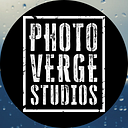My Year of Zines (and my first zine of the year)
‘Two Manifestos’ is a reflection of what I think is important to me as an artist in two of my chosen disciplines
I’m an entire month late when it comes to resolutions but here we are. Better late than never, I suppose.
Like the 1990 ABC special of Stephen King’s It, this blog post comes to you in two parts!
Part 1: Year of Zines
I haven’t blogged a lot here on Medium yet. If this is your first time reading anything by me: hi. My name’s Virgil and I go by Photoverge online sometimes. As my name implies, I am a photographer in the Pacific Northwest and I love making zines out of my photographs.
I want to get into it more in another post, but in 2022 I started taking my photography hobby more seriously. I self-published six zines and I figured in 2023 by starting early I could double that output. So 2023 has become my Year of Zines.
Ideally, I would like to make a zine a month but I think that with my schedule, I can’t commit to it. I can commit to making twelve and I think I can squeeze in time elsewhere when I am too busy or too uninspired to make a zine in a month. By the same token, if I am over-inspired, there is a real chance that I could make more than twelve. A lot of my zine making schedule revolves around the Grumpy Bean Cameras & Coffee Meetups. I try to make a first draft and print out a couple of copies to get feedback from fellow photographers. This was something I started last year and I am continuing this year. Sidenote: if you are in the Seattle area and want to check out the meet ups I encourage you to do so! Grumpy Bean Schedule here.
The additional task I am giving myself for my Year of Zines is to do a better job at making them available to be seen (online or physically) and for purchase. I say that I published six zines last year but I have only ever sold them or given them out in person. I was lucky enough to be a part of the first ever PCNW Zine & Book Fair (which warrants it’s own blog post) but I didn’t really take any action after the fact. I touch on it in the zine, but I have a responsibility for my work. That responsibility includes doing my level best to have my work seen by as many people as possible. So, the game plan for every zine I make this year is the following:
- Make a digital copy available
- Embed it in it’s own page on my website
- List it for sale on my Ko-Fi Page
- Write about it on Medium.
I am happy to say that I have been able to stick to that game plan for my first zine. So without further ado, I am happy to present to you, from Photoverge Studios:
Part Two: ‘Two Manifestos’ a zine by virgil.alonso
I intend for this part to act like a “behind the scenes” or a “directors commentary” feature on a Blu-Ray of a movie. Ideally, I would make an entry like this for every zine and have regular updates here on Medium as I make progress in my Year of Zines.
I should start with why I chose this topic. When I was brainstorming for zine ideas in late December, anticipating my Year of Zines, the idea of doing a manifesto as a zine came to my head. Most of the zines I have made so far are retrospectives. They are collections of photos from the archives, and they are combined to create a project with a theme once placed in context. ‘Two Manifestos,’ when read as a photo zine, is still very much in line with that practice.
What sets this zine apart is that it is the most text dense of all zines. The main content to be consumed is the text and the photography is there to supplement the text and help create composition on the page by placing the images and words in a strategic manner. I also felt mildly uncomfortable as a photographer creating a project that was text forward and where the images take a bit of a backseat. I tried to give my work a sense of justice by having the photos be layered on top of the text any time they intersect (literally: photos over words). When I brought my first draft to the Grumpy Bean Café, an artist educated me on the design principle “hierarchy of information” and pointed out how I stumbled into it.
While he really dug the zine, I received some other feedback not as receptive to the strong design choice of intentionally obstructing the words. This is a personal artist manifesto, and if I believe in the words I have written, why obscure them? I went home that day trying to find a way to keep the terms accessible but not change the layout.
Even before this month, I have been trying to find a way to make my zines digital. While PDFs are a viable solution, scrolling through a zine with your mouse was too removed from the experience I want somebody to have with my work. Enter HeyZine. HeyZine allows you to take PDFs and turn them into digital flipbooks. It’s enough of a paper zine simulacrum for me to like the solution. I uploaded the zine to HeyZine and boom, I have a digital zine.
I really like the features of this digital zine solution. You can embed the zine, which makes it easy for the website. You can create links in the zine. I have a QR code at the end of the zine to help people follow my on social media online and I was able to make it clickable. But the most interesting feature was a feature called ‘Background Audio.’
I am including a screenshot of the zine dashboard to show you what I am looking at. It feels like this is a feature that can be overlooked pretty easily. I definitely did initially. The way that “Background Audio” works is you upload a sound file like an .mp3 and then you indicate what page it starts on and ends on. I felt like this could be a cool way for me to do an audiobook version of this zine. I know all of the words so the obfuscation of text wasn’t going to be an issue. I paired the audio with a field recording to add some ambience. Don’t know why. It just felt right. Others have concluded that it also felt right.
When I recorded my audiobook reading, I did it all in one take. For future installments of text heavy zines, I will add audio in chunks and have the words on individual pages be read once somebody flips to the page. As a first attempt at adding audio to one of my zines, I think it went well.
To round out my thoughts and feelins on the zine, I want to talk about the overall aesthetic and presentation. The images and text are printed in grayscale on colored paper. None of the images are complete. Instead, I took some of my favorite photos and placed them in Canva’s automatic background remover. Some photos did not do well, the ones that survived the algorithmically destructive process got kept in the zine.
I did this for two reasons. One: I think the algorithmic process of deleting sections of a photograph feels like a Dadaistic process. While I don’t consider myself a Dadaist, I think letting the idea of chance into your artistic process can net you very interesting results. (Source)
Two: I am very much inspired by punk, diy, xerox zine aesthetic. Most of the photographers want to make zines of the highest quality. Who can blame them? They may be like me and feel like they have a responsibility to their work and they should present their work in the best quality possible. The downside is that their zines can end up being priced inaccessibly. This is one of the struggles I ran into last year. This year, I want to make an effort to make my zines as accesible as possible in every sense of the word. That’s why I will be making them available digitally on my website for free and why I wanted to design this zine to be printed with cost efficiency in mind (all black ink). By adding some color pages to the zine, the physical copies have the highlights of the image blend with the colored paper. I like the idea that having the physical zine will have a slight visual difference than the digital ones. Also, I was feeling too lazy to go and edit the pages to have blend modes to move the experience closer to the physical zines.
I want to take this time to quickly shout out a photographer I met at the PCNW Zine & Book Fair. His name is Leobardo Bañuelos Jr. and I was lucky enough to pick up Bardo Vol. 1 from him before we packed up and cleared out for the day. This zine is entirely in black and white, not even gray scale. It really opened my eyes to how effective a zine could be with no colors. That gave me a level of confidence to proceed with my method. You can check out Bardo Vol. 1 here. Sold out, unfortunately.
Conclusion
And with the conclusion of this Medium blog, I will have wrapped up the big steps I needed to take for my zine ‘Two Manifestos’. I really enjoyed writing about my experience with making the zine, getting all the thoughts and feelings out of my body and onto the blog post. If you want to read the zine, you can check it out on it’s dedicated page on my website:
Scroll to the bottom for the digital version. There is also a link to my Ko-Fi listing if anybody is interested in purchasing a physical copy.
I would love to know what you think! Either of the blog post or the zine. Feel free to leave any questions in the comments. Until the next zine!

